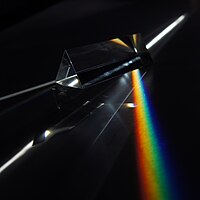
Photo from wikipedia
Big data and cognitive computing have a wide range of applications in smart homes, smart cities, artificial intelligence, and computational social systems. Visible light positioning systems have attracted more and… Click to show full abstract
Big data and cognitive computing have a wide range of applications in smart homes, smart cities, artificial intelligence, and computational social systems. Visible light positioning systems have attracted more and more attention as one of the application scenarios of computational social systems. In visible light positioning systems, the light-emitting diodes (LEDs) ceiling layout makes the smartphone usually obtain less than three LEDs in captured images. Due to the lack of necessary positioning information, most scholars combine the inertial measurement unit (IMU) with the modified filter algorithms to achieve positioning under the sparse light source. However, these systems have the following problems: 1) the azimuth angle obtained by the IMU is always not accurate, which decreases the positioning accuracy and 2) during the dynamic positioning process, the system’s initial position is difficult to automatically determine. In this article, we propose indoor high-precision visible light positioning under the sparse light source. First, we propose the geometric correction mechanism, which uses ellipse fitting to calibrate the azimuth angle, so as to increase the positioning accuracy for the static system. Then, we build a motion model for the entire positioning process through the unscented particle filter (UPF), which does not need to manually set initial state parameters, due to random generated particles. It can increase the positioning accuracy for the dynamic system. We evaluate our designed system, and the experimental results show that the average azimuth angle error is 2.04° and average positioning error is 8.8 cm, under the sparse light source.
Journal Title: IEEE Transactions on Computational Social Systems
Year Published: 2022
Link to full text (if available)
Share on Social Media: Sign Up to like & get
recommendations!